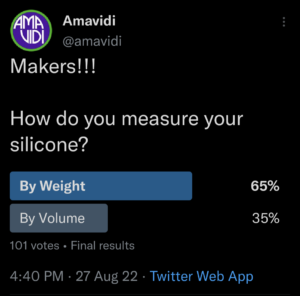
Measuring by Weight vs Volume for Making Indie Sex Toys – Which One wins?
Posted on
Last Updated

Posted on
Last Updated
Time to get geeky again!
Weight or Volume? Which is the better way to measure silicone?
Let's find out :)

There are 2 camps within the indie silicone sex toy community.
Those who use a scale to weigh their silicone components and those who use measuring cups.
But which is better? Should you use a scale? Or a measuring cup?
Weight? or Volume?
First, I won’t bury the lead: I think that measuring by weight is the better approach. I’ve tried both and I get better results when I use a scale.
I did an anonymous survey of indie sex toy makers and asked how they measured their silicone.
To say the least, I was surprised by the results!


I am a stickler for accuracy. If something is accurate, it’s repeatable and mistakes become super rare. But how accurate do we need to be? The silicone we use is actually very forgiving. You can be off +/- 10% and you won’t have any issues except maybe a slightly longer cure time. As you get farther out of balance you run the risk of a silicone that will fail to cure.
So why do I prefer measuring by weight? Well, there isn’t really a judgement call when the numbers are correct or they’re not. But even if I have to make a judgement call because I have 125g of Part A and 130g of Part B I know exactly what the difference is and I can either roll with it or correct it.
And that’s the second part – it’s easy to correct an imbalance because you know exactly what that imbalance is. Not only do you know which part needs to be added… you know exactly how much you need.
Also, there is less waste by using a scale. I can put my cup on the scale and zero it out. I add part A into the cup, zero out the scale and then add part B to the same cup. So, in this case, I have only used one cup.

Contrast that with measuring by volume. You have to have at least 2 cups if not 3. You could have a cup for Part A and a cup for Part B, compare them to make sure that are “even” and then add the Part B to the Part A.
What do you do with that cup that the Part B was in? Throw it away? Reuse it? You better be sure you only use it for Part B! If you mess up and reuse it for Part A, the residue of Part B will immediately start to react with the Part A as you add it.
And that brings up another issue with measuring by weight – there will almost always be some silicone component left in the cup. And if it is still in the cup, then it isn’t in your mix and so your mix is going to be out of balance. You can even this out by using 3 cups and transferring cup A and cup B into cup C, but now you’ve increased your waste.
I’ve seen some folks recommend mixing cup B into cup A and then transferring the mix back into cup B. That helps because you are going to be recovering some of that B cup reside in the transfer. But that just seems like extra work that could have been avoided in the first place.
Also, if you are measuring by volume, the size of your cup matters – specifically the diameter. The wider your cup, the larger your error is going to be. There’s a little math involved but I’ll keep it simple.
Let’s say you are looking at the cups from the side and you see a difference of 1mm in height, What is the difference?
In a 2″ cup, that 1mm = 2.03cc
In a 3″ cup that 1mm = 4.56cc
In a 4″ cup that 1mm = 8.11cc
Small errors become big errors as the diameter of the cup increases. This assumes cylinder shapes – conical shapes like measuring cups add volume as height increases!
So the larger the diameter of your cup the greater your error becomes. A cup that is twice as wide is 4 times less accurate.
Also larger cups have more surface area, so if you are trying to transfer your Part B into your Part A, you will leave more residue simply because there is more surface area for the silicone to stick to.
Note: I have been told “well, I just use the same measuring cup for part B so I don’t have to worry about the ‘Cup B/C’ issue.” You are totally, correct! You’ve solved one problem, but you haven’t solved the root problem which is the inherent inaccuracy of volume measurements.
(I will admit I haven’t done the math to figure out what the error percentage is on volume, but I’ll be honest… that’s math I don’t have time to do. I don’t have the time to justify someone else’s process. I know exactly how accurate my process is. If someone wants to do the math and geometry of cylinder/cone volumes to show me the accuracy, I’ll be happy to discuss it!)
I think that measuring by volume brings more problems to the table than measuring by weight. It leads to more waste and has more room for error.
Are these problems going to keep someone from making safe silicone dildos? Absolutely not!
But I like simplicity, efficiency and accuracy.
So that means that I will be measuring my silicone by weight for the foreseeable future.
Until next time…
